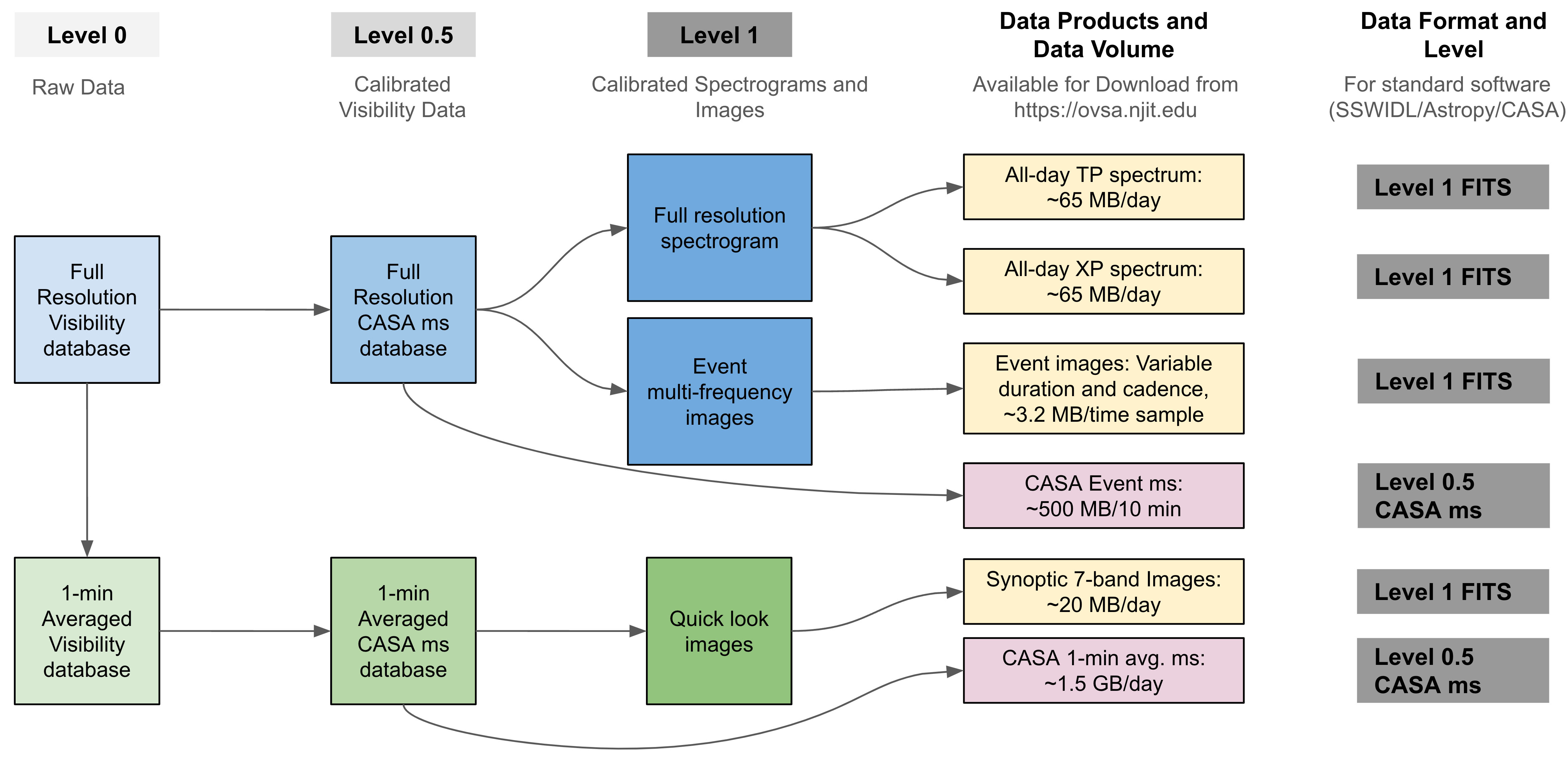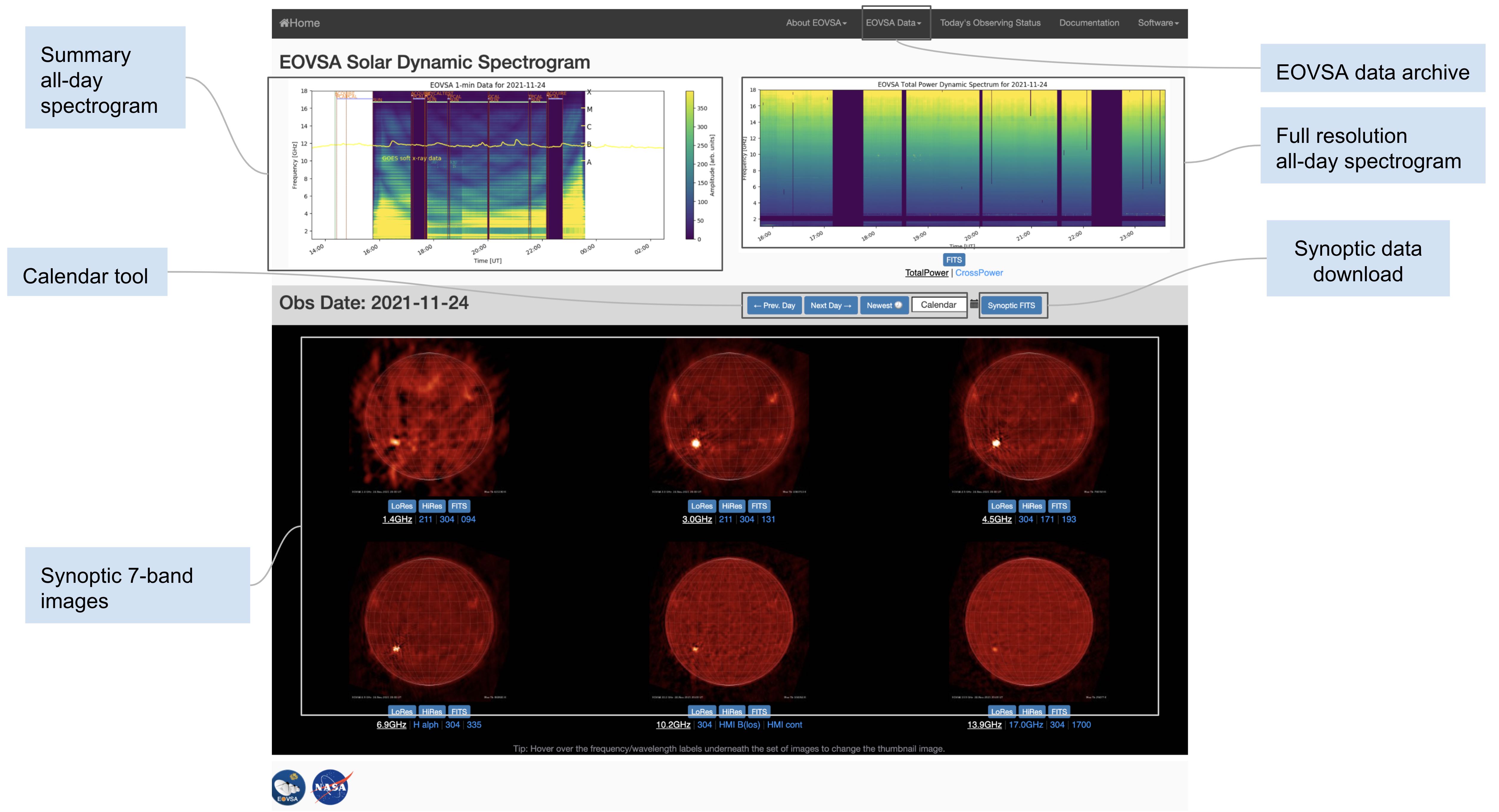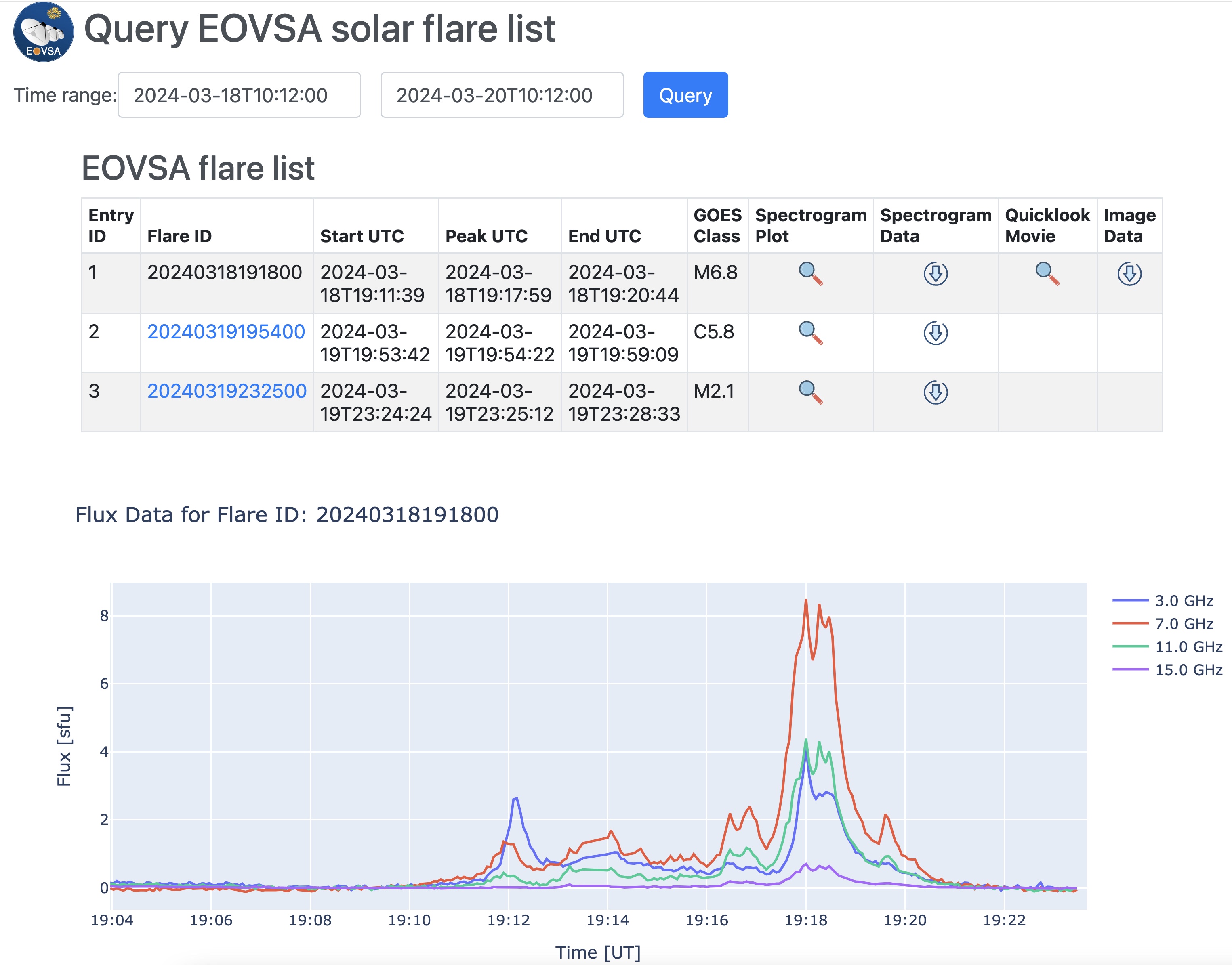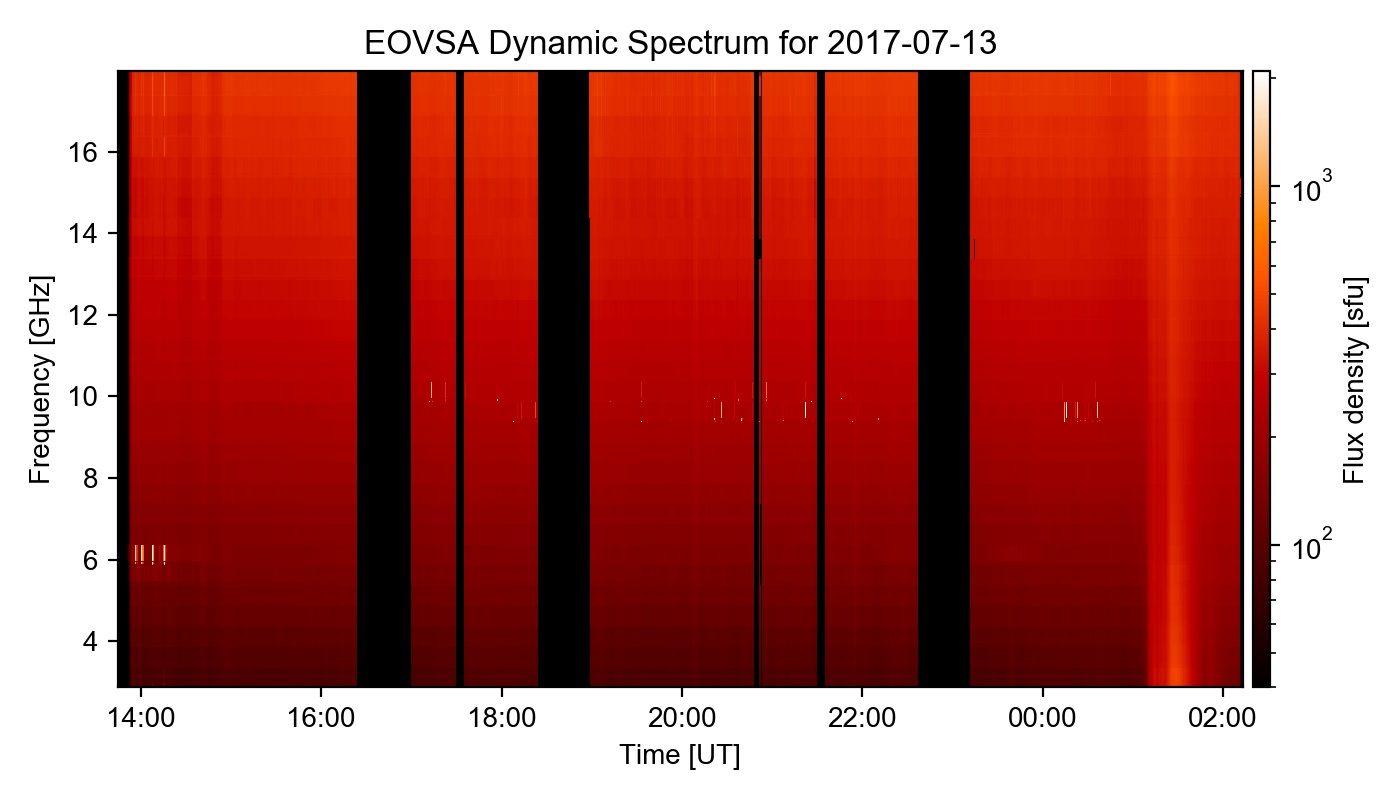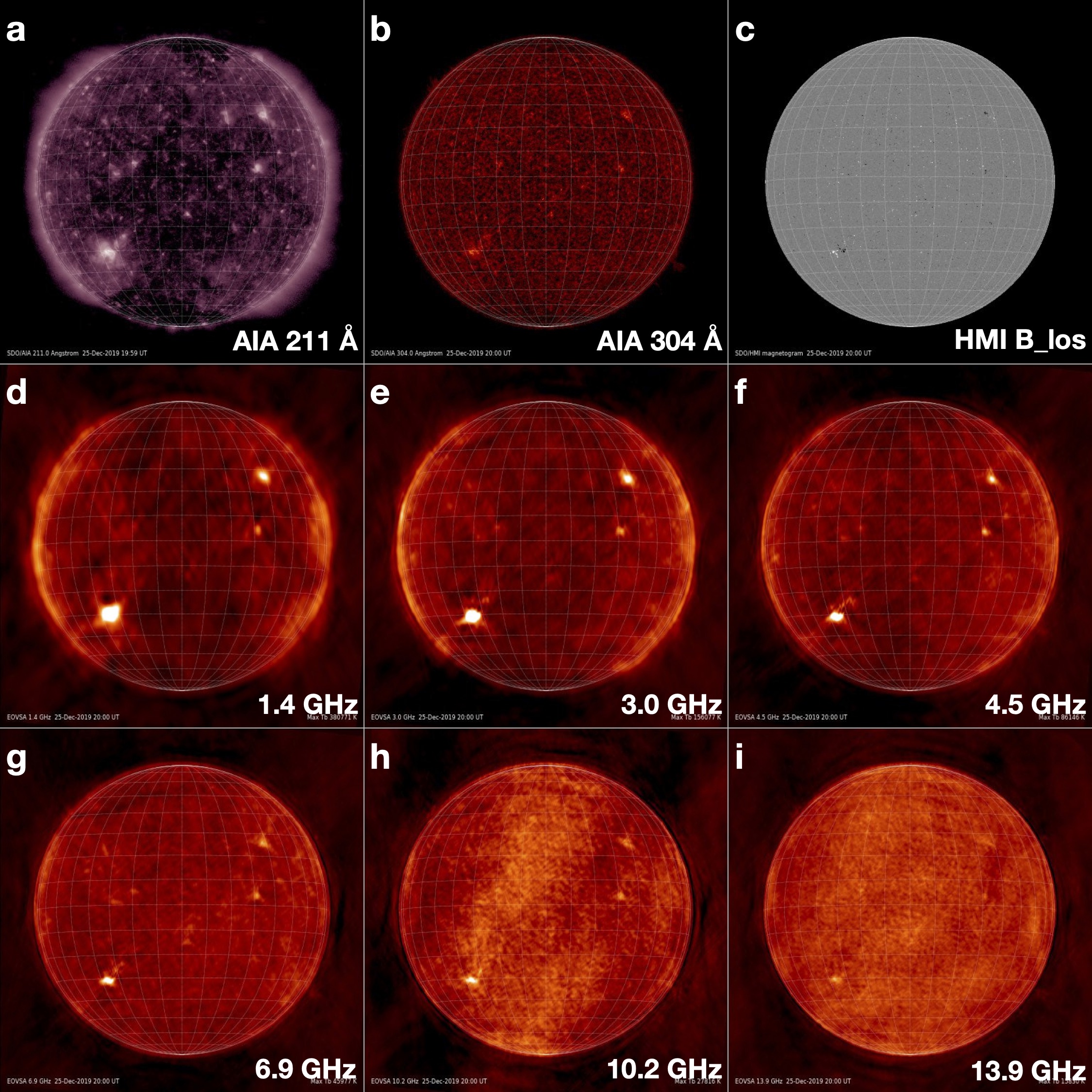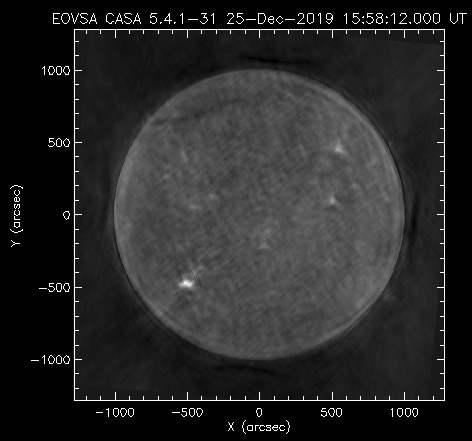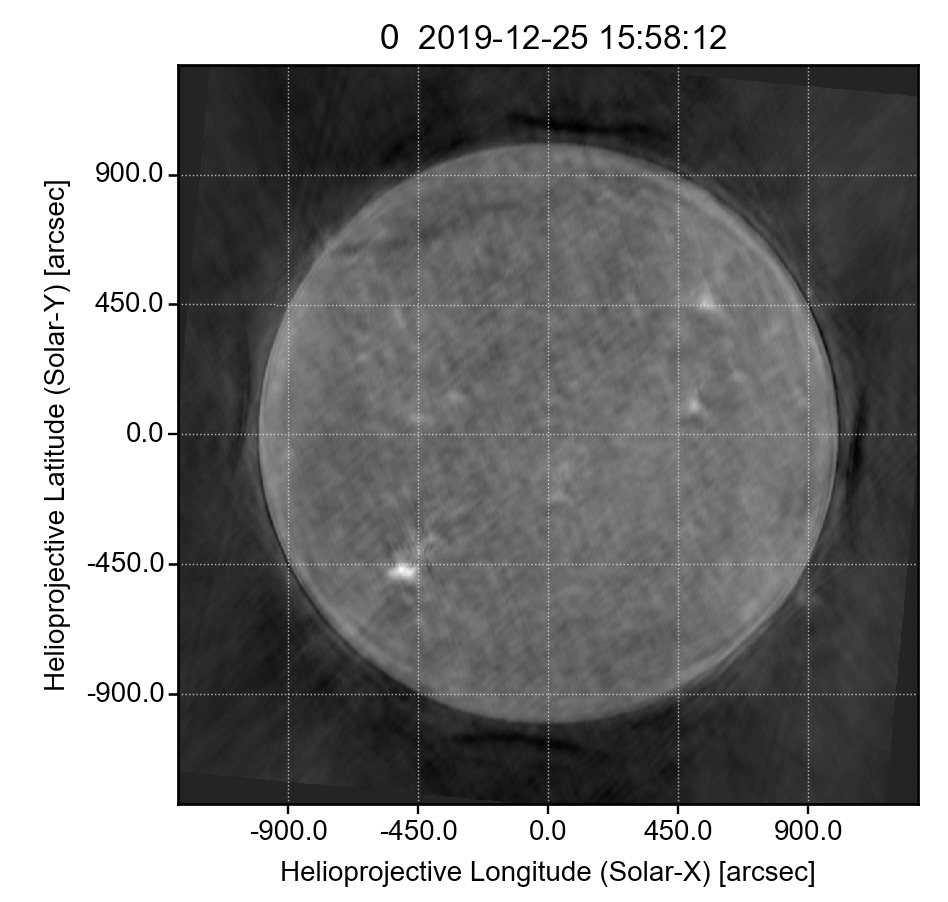EOVSA Data Products
Introduction
EOVSA observes the full disk of the Sun at all times when the Sun is >10 degrees above the local horizon (season dependent and ranges from 7-12 hours duration centered on 20 UT). EOVSA records data at 451 science frequency channels each second, in four polarization products, as well as additional total flux measurements from each individual antenna. Raw data in the visibility domain are processed through a pipeline processing system to produce images and spectrograms in the time- and frequency-dependent image plane (the block diagram in Figure 1 shows the data flow in the pipeline).
We deliver the radio interferometry data on the following three levels:
Level 0 - Raw visibility data from the instrument
As outlined in Figure 1, EOVSA creates raw data products in the left-hand column (labeled Level 0). This includes observations of cosmic sources for phase calibration, and gain and pointing observations required for total power calibration.
Raw "Interim" Database (IDB) visibility data
Full-resolution raw "Interim" Database (IDB) visibility data. They are stored in Miriad format, and hence may not be that useful for most people. Be patient after clicking the link--this is a very long list of directories, one for each available date. These data can be retrieved from the following page:
http://www.ovsa.njit.edu/fits/IDB/
Raw 1-min-averaged visibility data
This is the same as for the IDB data, except with 1-minute time integration applied. This is typically not useful for flares, but is perfectly fine for imaging active regions and full Sun. These data can be retrieved from the following page:
http://www.ovsa.njit.edu/fits/UDB/
Level 0.5 - Calibrated visibility data
After applying calibration and other preliminary processing to the raw (level 0) data, we create the CASA ms’s in the second column in Figure 1 (labeled "level 0.5"). These visibility data are in the Fourier domain of the true images in the plane of the sky and are not immediately ready for spectral imaging analysis yet. However, they have all of the required content to produce images and spectrogram data in standard FITS format (level 1.0). We provide a set of standard ms’s for each day (red boxes in Figure 1), for use by researchers who know how to deal with visibility data. These data are more suitable for experienced users to exploit the full potential of EOVSA data, such as spatially resolved spectral analysis. Processing these data requires CASA or sunCASA (https://github.com/suncasa/suncasa-src). Please refer to our tutorial at EOVSA_Data_Analysis_Tutorial_2022
Calibrated full-resolution visibility data for flare events
Calibrated and self-calibrated visibility data for flare events (purple boxes in Figure 1) will typically be available within 7 days after they are taken. They will be released at our flare list site soon: https://ovsa.njit.edu/flarelist
Self-calibrated 1-min-averaged visibility data
EOVSA 1-min averaged visibility data in CASA ms format can be retrieved from the following page:
http://www.ovsa.njit.edu/fits/UDBms_slfcaled
Level 1.0 - Images and spectrogram data in standard FITS format
Level 1.0 data are for users who prefer to work with spectrogram (frequency-time) and image data directly, which are also outputs of the pipeline system shown in Figure 1 (orange boxes). They are perfectly suitable to be used as context data for comparison with other multi-wavelength observations but are not (yet) intended for quantitative spatially resolved spectral analysis.
Spectrograms are provided as standard FITS tables containing the frequency list, list of times, and data in both total power (TP) and a sum of amplitudes over intermediate-length baselines (cross power or XP). Likewise, image data products are in FITS format with standard keywords and are converted into the Helioprojective Cartesian coordinate system compatible with the World Coordinate System (WCS) convention, along with correct registration for the spatial, spectral, and temporal coordinates. Both the spectrogram and image data products are calibrated and have physical radio intensity units (sfu for spectrograms and brightness temperature for radio images).
We provide the following data products:
- Synoptic products:
- All-day spectrograms:
- All-day synoptic images: Full disk images at 6 selected frequency bands centered at 1.4, 3.0, 4.5, 6.8, 10.2, and 13.9 GHz are produced once per day utilizing the earth-rotation synthesis, calibrated in brightness temperature. This is because EOVSA has a limited number of baselines and we need a long integration to fill up the uv domain in order to make full-disk images.
- Event-based products:
- Flare spectrograms: These are full time and frequency resolution spectrograms produced from the median of calibrated cross-power visibilities in FITS format, cropped to cover the flare duration. Preflare background is also subtracted. Compared to total-power spectrograms, these spectrograms have the advantage of revealing details of the flare evolution by "filtering out" the large-scale, continuous background from the visibilities. Note that for certain flares that have a large source size, the flux can be lower than its true values (as a fraction of the flux will be "resolved out").
- Pipeline-produced spectral images: We also have a semi-automated flare imaging pipeline to produce calibrated (and self-calibrated) images at 12-s cadence at up to 10 frequency bands. They are saved in standard FITS format and have been registered into Helioprojective coordinates. They can be read by SSWIDL or astropy/sunpy. These data have already been calibrated to physical units and are usually good to be compared with context data. But please be cautious when using them for quantitative spectral analysis.
| Category | Data Product | Naming Convention | Download Link |
|---|---|---|---|
| Synoptic Spectrograms | All-day TP Spectrograms | EOVSA_TPall_yyyymmdd.fts | https://ovsa.njit.edu/browser |
| All-day XP Spectrograms | EOVSA_XPall_yyyymmdd.fts | ||
| Synoptic Images | |||
| Synoptic 1.4 GHz images | eovsa_yyyymmdd.spw00-01.tb.disk.fits | ||
| Synoptic 3.0 GHz images | eovsa_yyyymmdd.spw02-05.tb.disk.fits | ||
| Synoptic 4.5 GHz images | eovsa_yyyymmdd.spw06-10.tb.disk.fits | ||
| Synoptic 6.8 GHz images | eovsa_yyyymmdd.spw11-20.tb.disk.fits | ||
| Synoptic 10.2 GHz images | eovsa_yyyymmdd.spw21-30.tb.disk.fits | ||
| Synoptic 13.9 GHz images | eovsa_yyyymmdd.spw31-43.tb.disk.fits | ||
| Flare Spectrograms | Full-resolution cross-power Spectrogram | eovsa.spec.flare_id_YYYYMMDDHHMMSS.fits | https://ovsa.njit.edu/flarelist |
| Flare Spectral Images | Pipeline-produced spectral images | eovsa.lev1_mbd_12s.YYYY-MM-DDTHHMMSSZ.image.fits |
Browsing and Downloading level 1 data
Synoptic level 1 data
EOVSA Level 1 synoptic data products can be retrieved with the following steps:
- Go to EOVSA browser page.
- Browse to the date of interest.
- Click "synoptic fits" button next to the calendar tool.
- Select the data product based on the names listed in the table above.
Flare level 1 data
EOVSA flare list with spectrograms and spectral images can be queried and downloaded at https://ovsa.njit.edu/flarelist. Users can use the top box to select a time range of interest and query our flare list. The results are displayed in the dropdown box. An interactive plot of the flare light curves will be shown at the bottom of the page once an event is highlighted (by clicking on the flare ID). Quicklook plots and FITS files of the spectrograms and flare movies can be accessed by clicking the icons in each flare record.
Reading and Using level 1 data
Introduction
All our level 1 data products are in FITS format. All the images have standard, WCS-compatible coordinates. Users can use their favorite method to read these files. In the following, we provide minimal examples to read them with Astropy and Sunpy.
Event-Based Data Products
- An example of how to read and plot the flare spectrograms and images in Python (with Astropy and SunPy) can be accessed at this Google Colab Jupyter notebook.
- We are working on an example with SSWIDL and will release it soon.
Synoptic Data Products
All-day Spectrograms
To read a spectrogram file in Python using the suncasa library:
from suncasa.eovsa import eovsa_dspec as ds from astropy.time import Time from matplotlib.colors import LogNorm ## Read EOVSA Dynamic Spectrum FITS file <filename> filename = 'EOVSA_TPall_20170713.fts' s = ds.get_dspec(filename, doplot=True, cmap='gist_heat', norm=LogNorm(vmax=2.1e3, vmin=40)) ## To access the data in the spectrogram object, use spec = s['spectrogram'] ## (Array of amplitudes in SFU, of size nfreq,ntimes) fghz = s['spectrum_axis'] ## (Array of frequencies in GHz, of size nfreq) tim = Time(s['time_axis'], format='mjd') ## (Array of UT times in astropy.time object, of size ntimes)
The get_dspec function is accessible on GitHub. For comprehensive guidance, please refer to suncasa's ReadtheDocs page.
The following code will read the spectrogram file in IDL:
function dspec,filename,doplot=doplot
; Read EOVSA Dynamic Spectrum FITS file <filename> and return a spectrogram object.
; Optionally show an overview plot if doplot switch is set
;
; Usage:
; s = dspec(<filename>) ; Returns spectrogram object
; s = dspec(<filename>,/doplot) ; Plots spectrum and returns spectrogram object
;
; To access the data in the spectrogram object, use
; spec = s.get(/spectrogram) (Array of amplitudes in SFU, of size ntimes, nfreq)
; fghz = s.get(/spectrum_axis) (Array of frequencies in GHz, of size nfreq)
; ut = s.get(/time_axis) (Array of UT times in anytim format, of size ntimes)
default,doplot,0
spec = mrdfits(filename,0)
freq = mrdfits(filename,1)
time = mrdfits(filename,2)
fghz = freq.sfreq
ut = anytim(time)
s = spectrogram(spec,ut,fghz)
if doplot then begin
window,/free,xsiz=1024,ysiz=600
; Find min and max of data from 5% to 95% of sorted array (eliminates outliers)
sarr = sort(spec)
dlim = minmax(spec[sarr[n_elements(sarr)*0.05:n_elements(sarr)*0.95]])
; Set drange with margin factor of 2 on low end and 5 on high end
s.set,drange=dlim*[0.5,5]
loadct,3
s.plot,/log,/xsty,/ysty,ytitle='Frequency [GHz]',charsize=1.5
endif
return,s
end
Synoptic 6-band Images
Full disk images at 6 selected frequency bands centered at 1.4, 3.0, 4.5, 6.8, 10.2, and 13.9 GHz are provided once per day, calibrated in brightness temperature.
The EOVSA full disk image FITS files are compressed with the RICE algorithm implemented in the FITS file handling module (astropy.io.fits) in Astropy. EOVSA FITS files are very similar to the compressed SDO/AIA FITS files from JSOC. Popular coding languages can easily read compressed images directly.
In IDL, you can use read_sdo in the ONTOLOGY package, which should be installed by default in SolarSoftWare (SSW), to read compressed EOVSA FITS files. The following code will read the EOVSA image FITS file in SSWIDL:
read_sdo,'eovsa_20191225.spw11-20.tb.disk.fits',header,data,/UNCOMP_DELETE index2map,header,data,eomap plot_map,eomap
In Python, you can use SunPy map module to read EOVAS FITS files. SunPy is an open solar data analysis environment for Python. The installation instruction can be found at SunPy official website.
import matplotlib.pyplot as plt from sunpy import map as smap eofile='eovsa_20191225.spw11-20.tb.disk.fits' eomap = smap.Map(eofile) eomap.plot() plt.show()
We have developed a package for EOVSA data processing and analysis:
SunCASA A wrapper around CASA (the Common Astronomy Software Applications package) for synthesis imaging and visualizing solar spectral imaging data. CASA is one of the leading software tools for "supporting the data post-processing needs of the next generation of radio astronomical telescopes such as ALMA and VLA", an international effort led by the National Radio Astronomy Observatory. The current version of CASA uses Python (2.7) interface. More information about CASA can be found on NRAO's CASA website . Note, CASA is available ONLY on UNIX-BASED PLATFORMS (and therefore, so is SunCASA). We are developing a new version of SunCASA based on CASA 6 (which offers a modular approach) so that users have the flexibility to build CASA tools and tasks in their Python environment.
Please follow this link for details regarding the installation of SunCASA on your own machine (only available on Unix-bases OS). This will take you to another page.
